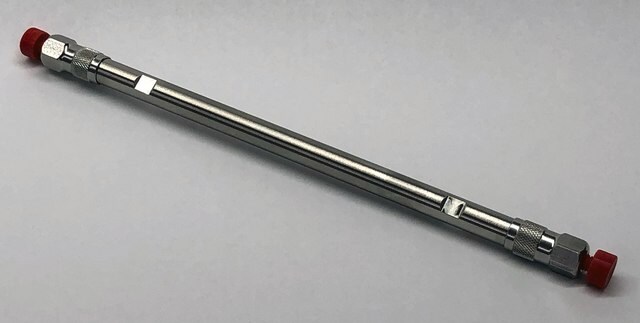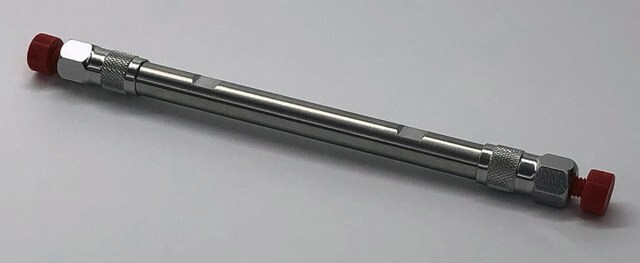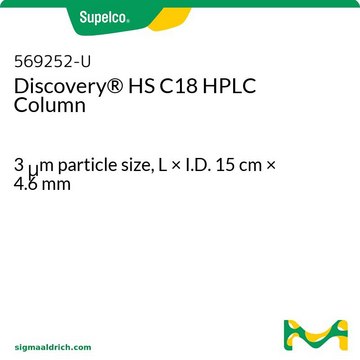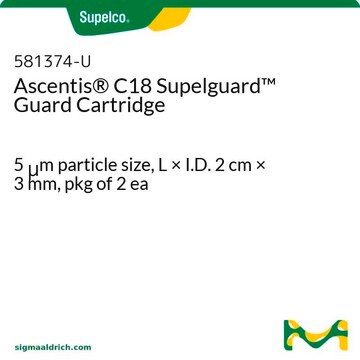581325-U
Ascentis® C18 (5 µm) HPLC Columns
L × I.D. 25 cm × 4.6 mm, HPLC Column
Sinônimo(s):
Ascentis RP18 HPLC Column
About This Item
Produtos recomendados
product name
Ascentis® C18 HPLC Column, 5 μm particle size, L × I.D. 25 cm × 4.6 mm
Materiais
stainless steel column
Agency
suitable for USP L1 (Similar to Phenomenex Luna C18)
linha de produto
Ascentis®
Características
endcapped
fabricante/nome comercial
Ascentis®
embalagem
1 ea of
Extensão da rotulagem
25% Carbon loading
Parâmetros
≤70 °C temp. range
400 bar pressure (5801 psi)
técnica(s)
HPLC: suitable
LC/MS: suitable
C × D.I.
25 cm × 4.6 mm
área da superfície
450 m2/g
cobertura de superfície
3.7 μmol/m2
Impurezas
<5 ppm metals
matriz
fully porous particle
silica gel high purity, spherical
Grupo ativo da matriz
C18 (octadecyl) phase
tamanho de partícula
5 μm
tamanho de poro
100 Å
operating pH range
2-8
aplicação(ões)
food and beverages
técnica de separação
reversed phase
Procurando produtos similares? Visita Guia de comparação de produtos
Descrição geral
Ascentis C18 is an extremely stable and reliable first choice HPLC column that gives symmetric peak shape and excellent retention even for difficult compounds.
Aplicação
- Identification of recombinant human insulin and biosynthetic insulin analogues by multiplexed targeted unlabeled mass spectrometry of proteotypic tryptic peptides.: This study utilized the Ascentis® C18 HPLC column for the separation of proteotypic tryptic peptides in the identification of insulin analogues, highlighting its application in targeted mass spectrometry for proteomic analysis (Qasem RJ et al., 2019).
- Development and validation of a novel stability-indicating HPLC method for the simultaneous assay of betamethasone-17-valerate, fusidic acid, potassium sorbate, methylparaben and propylparaben in a topical cream preparation.: This research developed and validated an HPLC method using the Ascentis® C18 HPLC column for the simultaneous assay of multiple compounds, demonstrating its robustness in stability testing of pharmaceutical formulations (Byrne J et al., 2014).
- HPLC-DAD and HPLC-ESI-MS/MS methods for metabolite profiling of propolis extracts.: The study employed the Ascentis® C18 HPLC column for metabolite profiling of propolis extracts using HPLC-DAD and HPLC-ESI-MS/MS, showcasing its effectiveness in complex natural product analysis (Pellati F et al., 2011).
- Practical comparison of 2.7 microm fused-core silica particles and porous sub-2 microm particles for fast separations in pharmaceutical process development.: This article compared different HPLC column technologies, including the Ascentis® C18, highlighting its performance in fast separations critical for pharmaceutical process development (Abrahim A et al., 2010).
Características e benefícios
- Excellent retention
- Symmetric peak shape
- High reproducibility
- Complete LC-MS compatibility
Informações legais
produto relacionado
Código de classe de armazenamento
11 - Combustible Solids
Classe de risco de água (WGK)
nwg
Ponto de fulgor (°F)
Not applicable
Ponto de fulgor (°C)
Not applicable
Escolha uma das versões mais recentes:
Já possui este produto?
Encontre a documentação dos produtos que você adquiriu recentemente na biblioteca de documentos.
Os clientes também visualizaram
Protocolos
-glucoside chloride; Malvidin 3-glucoside; Delphinidin 3-(6-acetylglucoside); Cyanidin 3-(6-acetylglucoside); Petunidin 3-(6-acetylglucoside); Peonidin 3-(6-acetylglucoside); Malvidin 3-(6-acetylglucoside); Malvidin 3-(6-caffeoylglucoside); Petunidin 3-(6-cumarylglucoside); Peonidin 3-(6-cumarylglucoside); Malvidin 3-(6-cumarylglucoside)
Nossa equipe de cientistas tem experiência em todas as áreas de pesquisa, incluindo Life Sciences, ciência de materiais, síntese química, cromatografia, química analítica e muitas outras.
Entre em contato com a assistência técnica








